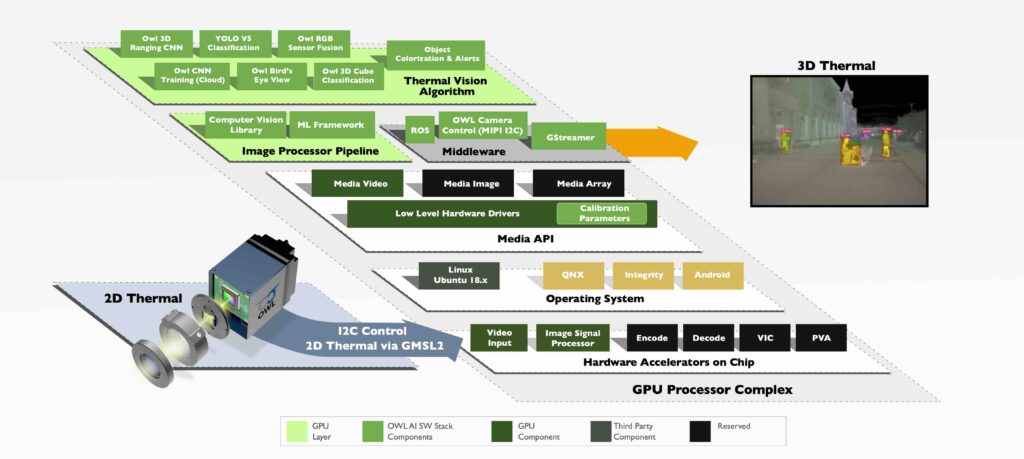Owl Autonomous Imaging has announced the availability of an Evaluation Kit for their new Thermal Ranger ADAS & Autonomous Navigation Development Platform.
This hardware and software kit enables Tier 1 and OEM automotive companies to easily evaluate Owl AI’s Thermal Ranger imaging solution for use in their Pedestrian Automatic Emergency Braking (PAEB) and other advanced driver assistance systems (ADAS) applications supporting L2, L2+ and L3/L4 requirements.
Owl’s monocular thermal camera solution enables 2D and 3D perception for object classification, 3D segmentation of objects, RGB-to-thermal fusion and highly accurate distance measurements.
“Our solutions deliver panoramic thermal imaging and dense range maps are superior to HDR RGB cameras, and/or LiDAR or RADAR sensors for difficult night and blinding light situations,” says Chuck Gershman, CEO of Owl Autonomous Imaging. “Unlike cumbersome stereo camera approaches, a single Owl AI 3D thermal camera delivers distance information throughout the entire field of view (FOV) and is immune to vehicle vibration for reliable and robust mapping. Thermal sensing is an important camera modality which can see in complete darkness as well as in blinding light, which is critical for pedestrian safety.”
The world’s only Monocular 3D Thermal Ranging Solution, the Thermal Ranger platform not only enables cars to see at night, it also enables the vehicle to know how far away the living object is and what it is.
Owl’s 3D Thermal Ranger currently provides VGA image resolution. However, in the near future, using our in-development HD imaging, Ranger will provide a 150X improvement in resolution and cloud density over other sensing modalities.
It operates day and night, in all weather, and definitively classifies vulnerable road users (VRUs) including pedestrians, cyclists, animals and vehicles, all the while calculating position and direction to enable safe autonomous and semi-autonomous vehicle operation.
When other cameras and perception sensors are blinded by the environment, thermal ranging cameras work.
The platform consists of a thermal imaging camera, an NVIDIA Jetson AGX Orin AI processor, and the Owl AI software suite including Convolutional Neural Networks (CNNs), ROS applications, AI/ML framework and drivers, and necessary cables and adapters. The CNNs operate on the thermal images to provide 3D Object classification and ranging information using the Robot Operating System (ROS) Publish/Subscribe interface. Several example ROS applications are also included.
All required software is supplied installed and ready for use. In addition to the software required for operation of the NVIDIA processor, the following modules are included: Owl AI/ML Neural Networks; Autonomous Emergency Braking application; 3D Birds-eye-view application; Object segmentation; Raw thermal video viewer; Raw thermal video recorder; Thermal with both 2D and 3D bounding boxes and colourised range dat
 Engineer News Network The ultimate online news and information resource for today’s engineer
Engineer News Network The ultimate online news and information resource for today’s engineer






